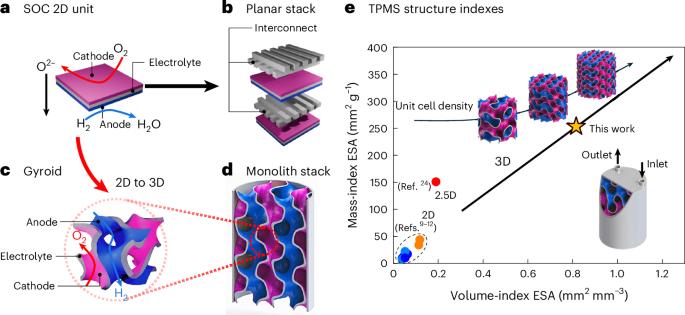基于增材制造的单片陀螺仪固体氧化物电池
IF 60.1
1区 材料科学
Q1 ENERGY & FUELS
引用次数: 0
摘要
固体氧化物电池(soc)可以有效地转换化学物质和电能。然而,它们主要局限于二维设计和制造技术。平面SOC堆叠需要复杂的多材料组件,从而降低了紧凑性和高比重。在这里,我们摆脱了2D范式,采用了基于三周期最小表面结构的真正3D设计,从而在重量和体积基础上实现了卓越的性能。利用增材制造的分辨率和精度,我们展示了一种单片陀螺仪SOC,消除了对金属互连和密封组件的需求。整体实现了最佳的空间利用,卓越的质量比指数,简单的制造过程和高电化学和热机械稳定性。在燃料电池模式下,比功率和体积功率密度分别超过1 W g−1和3 W cm−3,电解模式下的质量指数和体积指数产氢率分别约为7 × 10−4 Nm3 h−1 g−1和2 × 10−3 Nm3 h−1 cm−3,与平面堆叠相比提高了近一个数量级。本文章由计算机程序翻译,如有差异,请以英文原文为准。


Monolithic gyroidal solid oxide cells by additive manufacturing
Solid oxide cells (SOCs) efficiently interconvert chemicals and electricity. However, they are primarily confined to 2D design and fabrication technologies. Planar SOC stacks require complex multi-material components, leading to reduced compactness and high specific weight. Here we escape the 2D paradigm and adopt a true 3D design based on triply periodic minimal surface structures, enabling superior performance on gravimetric and volumetric bases. Leveraging the resolution and accuracy of additive manufacturing, we demonstrate a monolithic, gyroidal SOC that eliminates the need for metallic interconnects and sealing components. The monolith achieves optimal spatial utilization, exceptional mass-specific indexes, a straightforward manufacturing procedure and high electrochemical and thermomechanical stability. The specific power and volumetric power density surpass 1 W g−1 and 3 W cm−3 in fuel cell mode, and the mass-index and volume-index hydrogen production rates are about 7 × 10−4 Nm3 h−1 g−1 and 2 × 10−3 Nm3 h−1 cm−3 in electrolysis mode, nearly an order of magnitude enhancement compared to planar stacks. Solid oxide cells for interconversion of hydrogen and electricity typically have planar designs with low performance per unit mass and volume. Zhou et al. fabricate solid oxide cells with 3D architectures, improving space utilization and mass-normalized performance.
求助全文
通过发布文献求助,成功后即可免费获取论文全文。
去求助
来源期刊

Nature Energy
Energy-Energy Engineering and Power Technology
CiteScore
75.10
自引率
1.10%
发文量
193
期刊介绍:
Nature Energy is a monthly, online-only journal committed to showcasing the most impactful research on energy, covering everything from its generation and distribution to the societal implications of energy technologies and policies.
With a focus on exploring all facets of the ongoing energy discourse, Nature Energy delves into topics such as energy generation, storage, distribution, management, and the societal impacts of energy technologies and policies. Emphasizing studies that push the boundaries of knowledge and contribute to the development of next-generation solutions, the journal serves as a platform for the exchange of ideas among stakeholders at the forefront of the energy sector.
Maintaining the hallmark standards of the Nature brand, Nature Energy boasts a dedicated team of professional editors, a rigorous peer-review process, meticulous copy-editing and production, rapid publication times, and editorial independence.
In addition to original research articles, Nature Energy also publishes a range of content types, including Comments, Perspectives, Reviews, News & Views, Features, and Correspondence, covering a diverse array of disciplines relevant to the field of energy.
 求助内容:
求助内容: 应助结果提醒方式:
应助结果提醒方式:


